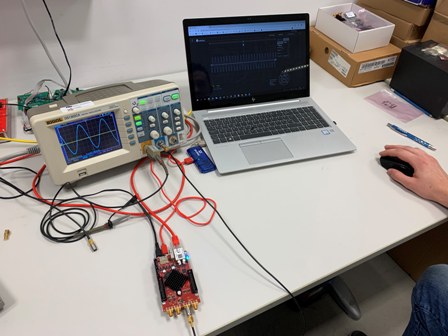Improved spec will allow STEMlab to compete with high-end dedicated instruments; original form-factor retained
 Slovenia, February 2019: Red Pitaya, the company that is pioneering the move to low cost, open-source, reconfigurable instrumentation with its credit-card-sized platform, has launched a new, uprated version of its STEMlab™ product that is tailored for HF+50MHz SDR (Software-Defined Radio) and RF applications that require DAQ systems with higher precision.
Slovenia, February 2019: Red Pitaya, the company that is pioneering the move to low cost, open-source, reconfigurable instrumentation with its credit-card-sized platform, has launched a new, uprated version of its STEMlab™ product that is tailored for HF+50MHz SDR (Software-Defined Radio) and RF applications that require DAQ systems with higher precision.
STEMlab 122.88-16 SDR comes with two 16 bit ADCs, 50 ohm inputs and 14 bit DACs, 50 ohm outputs. It uses the dual core ARM Cortex A9 offering massively better performance, the Xilinx Zynq 7020 FPGA for more real-time processing capabilities plus an ultra-low phase noise 122.88MHz clock which makes new the latest-generation STEMlab more hardware-compatible with HPSDR. 1Gbit Ethernet connectivity has been retained, and RF inputs have been improved in terms of distortion, noise and crosstalk which significantly improves reception and broadens the choice of antenna.
 STEMlab 122.88-16 SDR retains the original STEMlab form factor so it directly replaces the current platform. Comments Leon Živec, CEO Red Pitaya: “With this improved performance and affordability we believe that STEMlab 122.88-16 SDR will enable the Red Pitaya community to build SDR transceivers and other scientific devices that will be able to compete with high-end, dedicated instruments, yet retain the flexibility and simplicity of the Red Pitaya concept.”
STEMlab 122.88-16 SDR retains the original STEMlab form factor so it directly replaces the current platform. Comments Leon Živec, CEO Red Pitaya: “With this improved performance and affordability we believe that STEMlab 122.88-16 SDR will enable the Red Pitaya community to build SDR transceivers and other scientific devices that will be able to compete with high-end, dedicated instruments, yet retain the flexibility and simplicity of the Red Pitaya concept.”
STEMlab from Red Pitaya is a test and measurement environment that includes a board, an application marketplace and a source code library. It is designed as a low-cost alternative to many expensive measurement and control instruments. STEMlab can function as an Oscilloscope, Logic Analyser, Signal Generator, Spectrum Analyser and more, also performing other tasks like vector network analysis. It is based on high end FPGA technology, enabling software and hardware programming, coupled with very accurate high-end ADCs. Customizable at the FPGA and CPU levels, STEMlab can process real-world signals.






